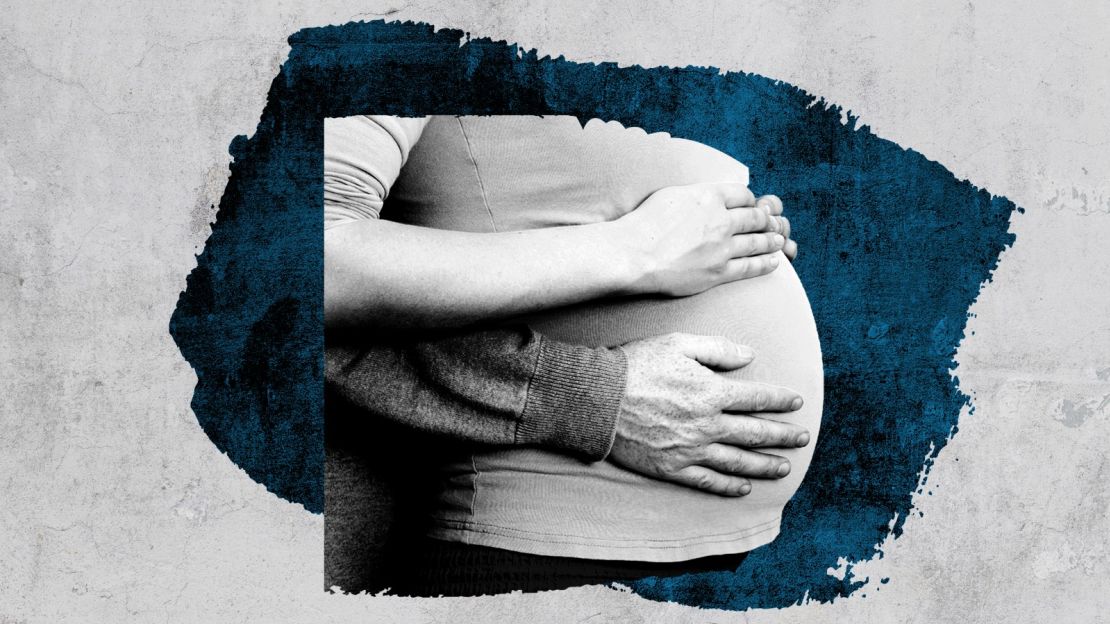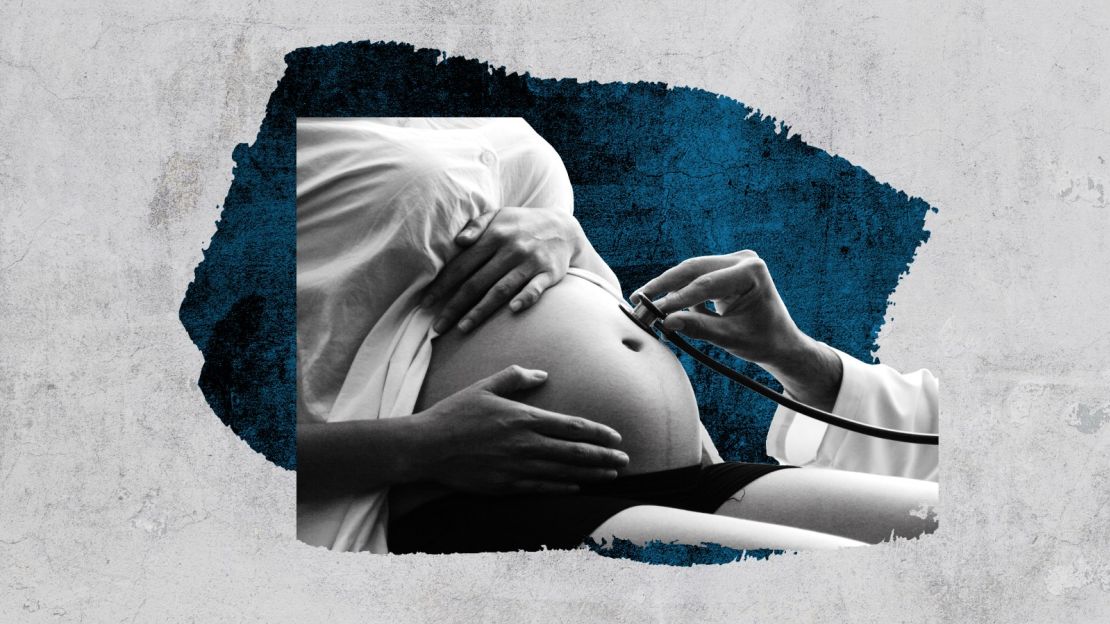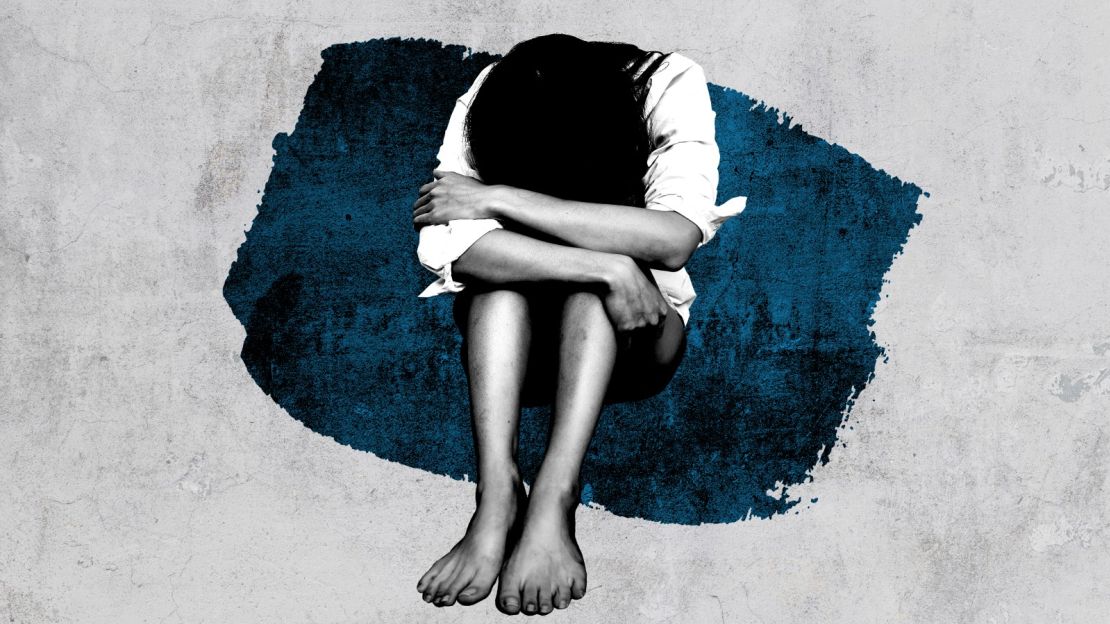Strangers have called them monsters, trolled them on social media and said their living children should be taken away. Their darkest moments are judged and politicized by figures who know nothing about them. They feel like involuntary pawns in an ugly, vicious game they didn’t ask to play.
Women who’ve had abortions later in their pregnancies are “bonded in a sisterhood through a club nobody ever wanted to be a part of,” one woman said.
She was one of half a dozen women who shared their stories with CNN earlier this year. They chose to speak up after President Donald Trump called on Congress to pass legislation that would ban “late-term abortion,” a phrase derided by ob-gyns.
We heard from women whose lives depended on terminating their pregnancies and others who learned that the babies they desperately wanted would not survive – or would suffer if they did. Some of them had signed onto an online open letter, titled “We are later abortion patients,” to give themselves and others voice.
We also talked to young women who felt desperate, alone, terrified and misled. One had been told she could not get pregnant because of various health conditions, including missed periods. Then, when she did, she unwittingly visited a faith-based pregnancy center, hoping to get an abortion. They told her she wasn’t as far along as she was, which made getting an abortion elsewhere more complicated.
A normal pregnancy lasts about 40 weeks. About two thirds of abortions happen at or before eight weeks, and almost all – more than 91% – occur before 13 weeks, the US Centers for Disease Control and Prevention reports. Another 8% happen at or before 20 weeks.
According to the professional organization American College of Obstetricians and Gynecologists, abortions after 21 weeks account for “slightly more than 1 percent of all abortions that occur in the United States.” Abortions later in the second trimester are “very rare,” and abortions in the third trimester are “rarer still.”
Because many states impose gestational age limits for abortion and deny insurance coverage for the termination of pregnancy, women who get abortions later in their pregnancies have few options. They often need to travel, adding to the cost of what can be a prohibitively expensive procedure.
One woman said she feels punished – yet again – for the loss of her son each time she makes the monthly loan payment on the thousands of dollars she borrowed to abort him. It was a decision she felt she had no choice but to make; the boy in her belly was missing multiple organs and never would have survived.
Some women insist on being named, refusing to hide. Others want to use first names only or pseudonyms, fearing backlash at a time when people seem quicker to hate than listen.
But by sharing their stories, these women – some mentioned above, others highlighted below – hope they can humanize a subject that’s hotly debated and, they say, gravely misunderstood.

She had to choose how her daughter would die
When people ask how many kids she has, Dana Weinstein tells them she has three living children. That’s because the daughter she lost 9½ years ago remains part of her.
She was happily married, the mother of a 2-year-old boy and thrilled to be pregnant again. She read stories and wrote a journal to the baby, and she relished when her son rolled his toy cars over her growing belly. Because she was over 35 and in “advanced maternal age,” she said, her care included additional sonograms later in her pregnancy.
When she and her husband went in for one at 29 weeks, they were told that the ventricles, or network of cavities, in their baby’s brain were larger than normal, she said. The doctor and technician said they weren’t “outrageously larger,” Weinstein remembered, so she didn’t worry. They could deal with whatever this was, she and her husband reasoned. Plus, everything else about their baby was perfect.
Still, she was sent to the Children’s National in Washington for further testing. Weinstein, who lives in Rockville, Maryland, was at 31 weeks, well into her third trimester, when they got an appointment. Then came the gut punch.
There are hard-to-spell words for the brain abnormalities their baby had: agenesis of the corpus callosum and polymicrogyria. In simpler terms, as Weinstein described it, a special MRI showed that the baby didn’t have the part of the brain that connects the right and left hemispheres. And where a healthy brain “looks like a cauliflower,” she said, their baby’s brain had concave areas and “pockets of empty.”
“What does this mean? What does this mean?” she kept asking, before they were whisked off to specialists who could explain.
Doctors expected their baby would not be able to suck or swallow, Weinstein recalled. They said she most likely would suffer from uncontrollable seizures upon birth and, because of that, a resuscitation order would be necessary. For as long as she lived, doctors predicted, their baby would require medical intervention.
And, as Weinstein understood it, she’d have no mental capacity to dream, love or enjoy life.
Her questions came fast. Couldn’t rehab help? What if they took stem cells from her son’s umbilical cord blood that she’d banked? Maybe they could regrow what her daughter needed?
Their baby’s brain was destined to be this way from the start, experts said. It could not have been detected earlier and would not improve. They never could have seen it coming. The multiple doctors she surveyed, searching for hope, told her the same.
“It’s just a fluke,” Weinstein said. “Basically, anyone who could get pregnant could be that fluke.”
They heard what a resuscitation order would entail. They listened to what an existence, short-lived or otherwise, would look like. They were briefed on hospice care.
At first, no one talked about the possibility of abortion this late in her pregnancy. Weinstein believes this was in part because the doctor to whom the hospital had referred rare patients like her in the past, Dr. George Tiller of Wichita, Kansas, had been murdered by an anti-abortion extremist weeks earlier.
She could carry the baby for six more weeks and deliver it, she was told. But that extended the nightmare she was living in, she said, one in which they had to choose how their daughter would die. She worried about what their choice would do to their son, their family, their marriage.
The endless kicks in Weinstein’s belly, the persistent movements that had given her so much joy, became unbearable. She feared that the baby was simply seizing and, worse yet, might be suffering. She fell apart and couldn’t sleep. While she had proudly worn cute maternity clothes to show off her bump, she now hid in her husband’s clothes. She dreaded the well-meaning question from strangers – “When are you due?” – and refused to leave the house.
“That agony of every moment till I could end her pain was just awful,” Weinstein said. Together with her husband, they decided to get an abortion. For this baby they loved, she said, it felt like the “more peaceful path for her passing.”
She had to fly across the country to Colorado to get the procedure. She felt lucky to have supportive parents who were able to charge the abortion expense, $17,500, on their credit card. She traveled with her husband, her mother and her son so she could have him to hold while at the hotel.
The doctor used a sonogram to find the baby’s heart. He gave Weinstein an injection through her stomach to stop its beating. She felt her daughter’s last movements before she passed away. A few days later, on the very day that marked her 32nd week of pregnancy, she delivered their deceased baby.
“I’m not going to talk through that part of it,” said Weinstein, who stayed calm on the phone but predicted she’d break down right after we hung up. “But I would like to say it was not a baby being ripped limb to limb. I delivered an outward-looking beautiful baby.”
Now 47, she and her husband went on to have two healthy daughters. The first one, now 8, Weinstein refers to as her “rainbow baby.”
“We call her that,” she said, “because after a storm, what’s more beautiful than a rainbow?”

Ending her pregnancy saved her life
The swelling was the first sign that something was wrong. It showed up in her hands and feet. She struggled to squeeze into shoes.
Susan flipped open her “What to Expect When You’re Expecting” book and turned to the section that outlined when to call a doctor. Her kind of swelling and sudden weight gain – she’d put on 11 pounds in one week – made the list.
She asked her husband of just over a year, a physician, whether he thought she looked OK. He sweetly told her she was beautiful, first thinking she was self-conscious and worried that she was fat.
He wasn’t an ob-gyn, so she called hers.
“Have your husband take your blood pressure, just when he’s able to,” the doctor advised.
On their way to dinner in Berkeley, California, that evening, he suggested that they swing by his office first.
Her blood pressure “was off the charts,” Susan remembers 30 years later. Her husband dialed the obstetrician, who asked whether he had any urine testing strips handy. He did, and they showed that Susan’s protein levels were dangerously high, indicating a problem with her kidneys.
“Get over to the hospital right away,” the obstetrician ordered.
Susan at first balked. She felt fine, just swollen. Plus, she was hungry.
“Can’t we go to dinner first?” she asked before being rushed out the door.
She stayed in denial for as long as she could. Doctors were alarmed about her blood pressure, but she wasn’t. They said her kidneys were shutting down, but that didn’t register. Instead, she focused on the ultrasound they took, which revealed the baby’s gender.
She looked with excitement at her husband.
“Oh, my goodness, we’re going to have a boy!” she said. “Aren’t you happy?”
His face was grim, she remembered. “He knew that this was not looking good at all.”
She was at 24 weeks and had severe preeclampsia. Doctors said she was on the verge of having a stroke.
“It’s like you’re being poisoned by pregnancy,” she said, explaining her condition, “And the only way to cure it is to not be pregnant.”
The fetus was behind in its development and not where it should be at 24 weeks.
It “needs at least two weeks to be even minimally viable, and you just don’t have two weeks,” the doctors told her. “You don’t have two days.”
Still, she tried to negotiate a deal. She was a physical therapist. She could rehab herself after a stroke, she told them. She could rehab their baby. She wanted to deliver it, if not vaginally, then by C-section. They said her body could not withstand either.
They promised her the fetus would feel no pain before stopping its heartbeat. Then they put Susan under to perform the dilation and evacuation procedure, in which the cervix is dilated and the contents of the uterus extracted.
Her abortion was a necessity and felt like “such a no-choice choice,” said Susan, 59, who later had two daughters.
It wasn’t what she wanted. It was what she needed to live.

Her biological mother abandoned her. She refused to do the same
She was 19 and living with a host family in Florida when she learned that she was pregnant.
“Katherine,” not her real name, was in the United States on a student visa. She’s from Honduras, which has a total ban on abortion, and got pregnant over the summer while visiting home.
She was confused, though. The older man she’d dated in Honduras bought a Plan B pill on the black market, she said, and told her to take it. She didn’t know what it was or how it worked. When she didn’t get her period, she assumed that her hormones were just out of whack because of that strange pill.
After a few months back in the United States, though, her body felt and looked different. The home pregnancy test she bought at Walmart was positive, but she clung to the movie plotlines she’d seen where tests came back with false results.
When the father in her host family asked whether she was pregnant, she said, “No! Why are you asking?”
She was terrified and didn’t know where to turn. She told the man she’d dated in Honduras that she was pregnant, “but he wasn’t supportive,” she said. “He said, ‘I don’t care.’ “
She didn’t want to disappoint her family back home. If her host family in Florida learned the truth, she feared, they’d send her back. Katherine had dreams, she said, that depended on staying in college.
She could barely concentrate during her final exams – “It was the worst semester of my life,” she said – and then she moved to Texas to transfer to a new school.
In the Lone Star State, she felt even more alone. She said she knew no one. By late January 2016, she had clarity: She could not have this baby.
She remembered hearing about a man in her Honduras neighborhood who secretly performed abortions, but she couldn’t figure out who he was. She learned that abortions were legal in the United States but worried she could never afford one. Then she began searching for options in Texas and found a place near where she lived. Even better, when she called, she was promised a free pregnancy test and ultrasound.
The clinic first made her watch a video. It was about God, adoption and parenting, she remembered. It featured women who shared testimonies about the abortions they regretted. Katherine watched but didn’t understand their sadness. She’d unknowingly walked into a faith-based clinic that didn’t offer abortions. She sat through the video she didn’t buy into because, she said, “I just wanted help.”
The ultrasound showed that she was at 30 weeks, further along than she anticipated.
“There’s a place where they can pay you for college, and you can stay there to have the baby,” Katherine remembered a woman at the clinic told her.
Maybe that was an option, she thought at first, but it wasn’t what she wanted. She’d bring a baby into the world only if it had its parents, both of them. She wasn’t ready to raise a child. And driving her as much as anything: She refused to be like her own biological mother, who abandoned her in the hospital after she was born.
“That’s not the point of my life, repeating the same story,” she said. “I didn’t want for my baby to feel the same way I feel. … I’m 23, and I’m still asking these questions about what happened.”
She insisted that she wanted an abortion.
“In Texas, it is illegal for you to have an abortion after 20 weeks,” the woman at the clinic said. “You’re going to have to have the baby.”
The woman asked whether she wanted her ultrasound pictures. Katherine said she didn’t. The woman gave them to her anyway. As soon as she got home, she threw them away and sobbed.
Then, she turned frantic. She went online to research where she could go and found only two options. She called a clinic in New Mexico, which referred her to a sister clinic in Texas for an exam. That clinic confirmed how far along she was and heard her pleas. They couldn’t give her what she wanted, though, but placed a call to New Mexico for her.
They’re “willing to help you,” she remembered hearing. “But it’s going to cost you $12,000.”
Given how far along she now was, her appointment was quickly put on the schedule. She had just three days to find the money, she said.
She worked the phones and fired off emails. With the help of a network of abortion funds that support women who can’t afford these procedures, Katherine said, she pulled together $9,000. She begged the clinic in New Mexico to still take her.
A third-trimester abortion provider in New Mexico, who didn’t want to be named and couldn’t speak directly to Katherine’s case, offered this to explain why someone like her would be accepted for the procedure.
“My patients of all gestational ages share this commonality: Whatever their story, they have come to the decision that an abortion is absolutely necessary to preserve their mental or physical health and/or to save their unborn child from a life of suffering,” the physician wrote in an email.
Katherine was in a nervous haze the day she walked in the clinic doors. She didn’t recall the injection that stopped the fetal heartbeat. She also couldn’t name the medication she was given, but she definitely remembered the cramping that seized her body later at the hotel. Only after the fact did she realize that she’d gone into labor.
“I was in pain you can’t imagine. I wanted to die,” she said. “With that pain, I really was regretting having an abortion.”
But that regret was short-lived. Two days later, when she “gave birth to a dead fetus” at the clinic, she said, she was overcome with tears of relief.
Get CNN Health's weekly newsletter
Sign up here to get The Results Are In with Dr. Sanjay Gupta every Tuesday from the CNN Health team.
“Thank you for changing my future,” she remembered saying.
Katherine, who to this day has never told a friend or family member about her abortion, knows that some people may read her story and think the worst of her. But it’s her body, her life, and she knew what she could – and couldn’t – handle, she said.
She’s baffled by the outcry against abortion. She thinks about all the children in the United States and elsewhere who don’t have loving homes and aren’t given a fair chance.
“You want the orphanages to have more kids?” she asks. “You want more kids on the street?”
She looks forward to being a mother someday, she insists. But she’ll do that with a supportive partner when she’s older, maybe 30, when she’s become the woman she plans to be.




























